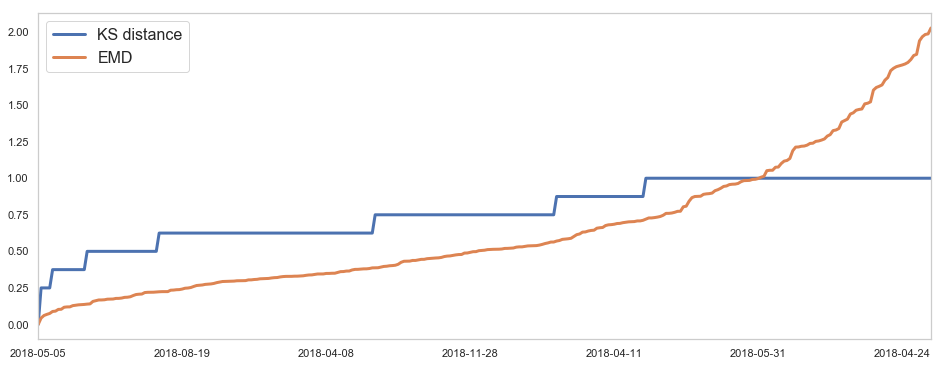Review: Detecting anomalies using statistical distances(with Mathematical additions)¶
Minjung Gim(mjgim@nims.re.kr, https://mjgim.io/slides/anomaly/mjgim.html)¶
2019¶
Contents¶
- SciPy 2018 talk overview
- Detailed review with Mathematics
- Implementations and applications
- Further analysis of Wasserstein distance
- With Linear Programming
- Why Wasserstein distance is weak
SciPy 2018 talk overview¶
Detecting anomalies using statistical distances¶
- Anomality(outlier), probability distributions, statistical distances between two samples
- KS distance and Wasserstein distance
- Introduction of contribution to SciPy
- Add EMD and Cramér–von Mises statistical distances: https://github.com/scipy/scipy/pull/7563/

For example, is the current latency distribution anomalous?¶

Detailed review with Mathematics¶
Probability distribution¶
- $K$: State space (For instance, $K=\mathbf{R}$ or compact subset in $\mathbf R^d$)
$\mathcal F$: $\sigma$-algebra(field) on $K$
- $K\in \mathcal F$
- If $A\in \mathcal F$, then $A^c \in \mathcal F$
- closed under countable union
Probability measure $\mathbf P$ on $(K, \mathcal F$)
- set function $\mathbf P : \mathcal F \to \mathbf R^+$ with $\mathbf P(K)=1$ (non negativity, null empty set, countable additivity)
- Probability distribution can be regarded as probability space $(K,\mathcal F,\mathbf P)$
Example1(continuous)¶
- $K = \mathbf R^d$, $\mathcal F$ $=\mathcal B(\mathbf R^d)$, Borel sets
- For $A\in \mathcal F$,
where
$$ p(x)=\frac{1}{\sqrt{(2\pi)^d |\Sigma|}} \exp \left(-\frac{1}{2} (x-\mu)^T \Sigma^{-1}(x-\mu) \right), $$mean vector $\mu\in \mathbf R^d$, covariance matrix $\Sigma \in \mathbf R^{d\times d}$, and det$(\Sigma)=|\Sigma |$.
Example2(discrete)¶
- $K=\{ 1$$,2,3 \}$
- $\mathcal F=$ $\mathcal P(K)$, power set
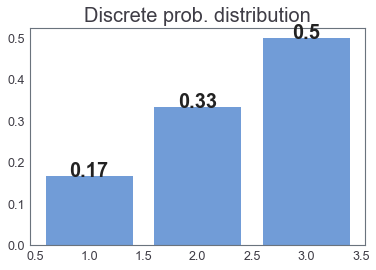
Main Goal: Compare two distributions¶
Let $B$ and $T$ be $\color{red}{\bf{unknown}}$ 1-dimensional prob. distributions.
$K:=\mathbf R$, $\mathcal F:= \mathcal B(\mathbf R)$
$$ B=(\mathbf R,\mathcal F,\mathbf P), \,T=(\mathbf R,\mathcal F,\mathbf Q)\, \text{ two prob. spaces} $$Goal: Compare two samples drawn from $B$ and $T$¶
$$ B_N=\{ b_1, ..., b_N \}, \, b_i \text{ are ordered iid samples(observations) of } B $$$$ T_M=\{ t_1, ..., t_M \}, \, t_j \text{ are ordered iid samples(observations) of } T $$$b_i, t_j \in \mathbf R$.
Hypothesis¶
- $H_0 :=$ Both samples are drawn from the same distributions
- $H_a :=$ not $H_0$
Let us see single sample statistics¶
from scipy import stats
import scipy
import numpy as np
import seaborn as sns
import sys
import matplotlib.pyplot as plt
%matplotlib inline
print("Python version:", sys.version)
print("SciPy version:", scipy.__version__)
print("Numpy version:", np.__version__)
Python version: 3.7.5 (default, Oct 25 2019, 10:52:18) [Clang 4.0.1 (tags/RELEASE_401/final)] SciPy version: 1.3.1 Numpy version: 1.17.2
samples_plot()
mean of B: 0.0014967465194965612 mean of T: 1.9376262306655623
mean of $B$ $<$ mean of $T$¶
samples_plot2()
mean of B: 29.305597048792578 mean of T: 28.78169180732947 perc_95(B): 56.84203149774353 perc_95(T): 40.53775471037561
mean of $B$ $\sim$ mean of $T$ but $perc_{95}(T)< perc_{95}(B)$¶
samples_plot2()
mean of B: 23.93157906343227 mean of T: 28.78169180732947 perc_95(B): 40.509331827626426 perc_95(T): 40.53775471037561
$perc_{95}(T) \sim perc_{95}(B)$, but mean of $B$ $<$ mean of $T$¶
Simple sample statistics are not enough!¶
- Mean, median, TrMean, percentilie, standard deviation, skewness, IQR, ...
Need: statistical distance to measure difference between two samples¶
Focus on CDF!!¶
cum_plot()
KS distance 0.5595587206396802
KS distance(Kolmogorov-Smirnov) between 1-d two samples¶
- Non parametric method for comparing two samples
- Idea: comparing two empirical distribution functions(CDF)
 $$
KS(B, T):= \sup_{x\in \mathbf R} \left | F_B(x) - F_T(x) \right|
$$
$$
KS(B, T):= \sup_{x\in \mathbf R} \left | F_B(x) - F_T(x) \right|
$$
where
$$ F_B(x):= \frac{1}{N} \sum_{i=1}^N \chi_{(-\infty,x]}(b_i)= \frac{1}{N}\cdot \left(\# \, \text{of} \, b_i \leq x \right), $$and $\chi$ is an indicator function.
Decision rule of KS test¶
If
$$ KS(B,T) > \sqrt{ -\frac{\log(\alpha)}{2} } \sqrt{\frac{N+M}{NM}}, $$then the null hypothesis is rejected.
- $\alpha$: significant level(i.e. 0.05)
- $1-\alpha$: confidence coefficient
Or the p-value of $KS$ test $<$ $\alpha$, then $H_0$ is rejected.
KS distance is a metric.¶
Let $X$, $Y$, $Z$ be probability distraibutions.
$KS(X,Y)$ $\geq 0$
$KS(X,Y)$ $= 0$ if and only if $X=Y$
$KS(X,Y)$ $=$ $KS(Y,X)$
$KS(X,$ $Z)$ $\leq$ $KS(X$$,Y) +$$KS(Y$$,Z)$
KS distance in SciPy¶
scipy.stats.ks_2samp(data1, data2)
Computes the Kolmogorov-Smirnov statistic on 2 samples.
This is a two-sided test for the null hypothesis that 2 independent samples are drawn from the same continuous distribution.
- Parameters
- data1, data2: sequence of 1-D ndarrays, two arrays of sample observations assumed to be drawn from a continuous distribution, sample sizes can be different
- Returns
- statistic : float, KS statistic
- pvalue : float, two-tailed p-value
Example¶
from scipy import stats
n1 = 200
n2 = 300
For a different distribution, we can reject the null hypothesis since the pvalue is below 1%:
rvs1 = stats.norm.rvs(size=n1, loc=0., scale=1)
rvs2 = stats.norm.rvs(size=n2, loc=0.5, scale=1.5)
stats.ks_2samp(rvs1, rvs2)
(0.20833333333333337, 4.6674975515806989e-005)scipy.stats.ks_2samp(data1, data2)¶
data1 = np.sort(data1)
data2 = np.sort(data2)
n1 = data1.shape[0]
n2 = data2.shape[0]
data_all = np.concatenate([data1, data2])
cdf1 = np.searchsorted(data1, data_all, side='right') / (1.0 * n1)
cdf2 = np.searchsorted(data2, data_all, side='right') / (1.0 * n2)
d = np.max(np.absolute(cdf1 - cdf2))
# Note: d absolute not signed distance
en = np.sqrt(n1 * n2 / float(n1 + n2))
try:
prob = distributions.kstwobign.sf((en + 0.12 + 0.11 / en) * d)
except:
prob = 1.0
return Ks_2sampResult(d, prob)
cum_plot()
KS distance 0.29533333333333334
cum_plot(kde = False, bins = 1)
KS distance 0.5001666666666666
KS distance between two uniform distributions¶
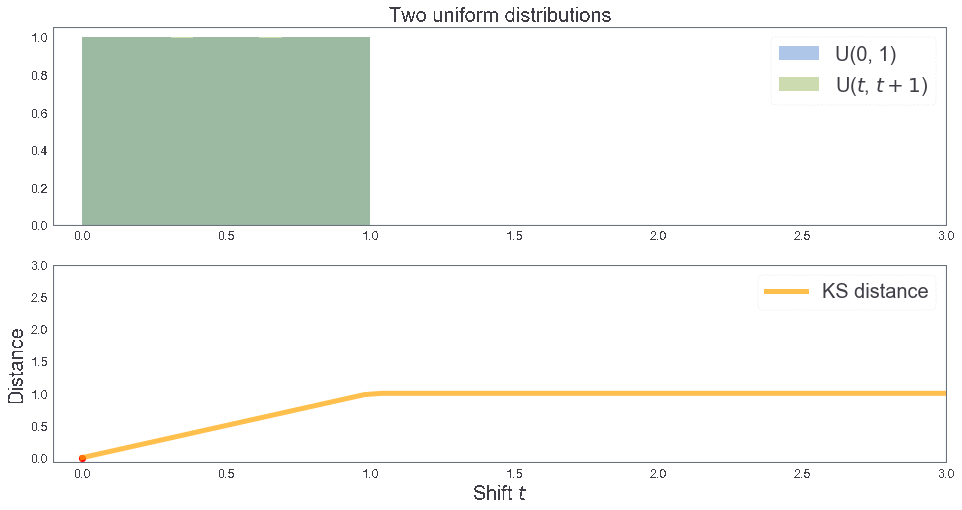
3 samples: B, T, T'¶
two_cdfs()
KS distance 0.1996667777407531 KS distance 0.1996667777407531
Need: more appropriate distance¶


Joint Probability distribution with marginal $B$ and $T$¶
Continuous version¶
$$ \Gamma(B, T):= \left \{ \gamma: K \times K \longrightarrow \mathbf R^+\text{ s.t. }\int_K \gamma(x,y)dy = B(x)\text{ and }\int_K \gamma(x,y)dx = T(y) \right \} $$where $B(x)$ (resp. $T(y)$) is a density function of $B$(resp. $T$).
$\Gamma(B,T)$ is a set of pdf on $K\times K$ whose marginal dfs are $B$ and $T$.
Discrete version¶
$$ \Gamma(B, T):= \left \{ \gamma: K \times K \longrightarrow [0,1]\text{ s.t. }\sum_{y\in K} \gamma(x,y) = B(x)\text{ and }\sum_{x \in K} \gamma(x,y) = T(y) \right \} $$where $B(x)$ (resp. $T(y)$) is a probability mass function of $B$(resp. $T$).
$\Gamma(B,T)$ is a set of pmf on $K\times K$ whose marginal pmf are $B$ and $T$.
Earth mover's distance a.k.a. $1^{st}$ Wasserstein distance¶
(introduced by Leonid Vaseršteĭn(Russia))
$$\begin{align*} EMD(B,T) = W_1 (B,T) &= \inf_{\gamma \in \Gamma(B,T)} \int_{K\times K} |x-y| d\gamma(x,y) \quad \text{(continuous)}\\ & \\ &=\inf_{\gamma \in \Gamma(B,T)} \sum_{x,y} |x-y| \gamma(x,y) \quad \text{(discrete)} \end{align*} $$Remark¶
- $EMD(B,T) = \inf_{\gamma \in \Gamma(B,T)} E_{(x,y) \sim \gamma} \left [ |x-y| \right ]$
- $\gamma(x, y)$ can be seen as an amount of sand to move from $x \in B$ to $y \in T$
- Intuitively, $EMD$ is a minimum cost to move sand to another region(Optimal transport problem)
Another formulation $\color{red}{only}$ in case $K = \mathbf R$¶
Let $K = \mathbf R$. Then we have another formulation:
$$ EMD(B,T) = \int_{\mathbf R} |F_B(x) - F_T(x)| dx $$where $F_B$ is the CDF of $B$.
- Ref: On Wasserstein Two Sample Testing and Related Families of Nonparametric Tests
For your information, KS distance was the following:
$$ KS(B, T):= \sup_{x\in \mathbf R} \left | F_B(x) - F_T(x) \right| $$Remark¶
- $B$$=$ $\delta_s$ and $T$$=$ $\delta_t$, $s,t$ $\in$ $ \mathbf R$
$\quad \Rightarrow EMD(B, T)=|s-t|.$¶
- $B=N(\mu_1, C_1)$ and $T=N(\mu_2, C_2)$ on $\mathbf R^d$ where mean vectors $\mu_1, \mu_2 \in \mathbf R^d$, covariance matrices $C_1, C_2 \in \mathbf R^{d\times d}$.
$\quad \Rightarrow W_2(B, T)^2= \| \mu_1 - \mu_2\|^2 + tr(C_1 +C_2 -2 (C_2^{1/2} C_1 C_2^{1/2})^{1/2}).$¶
1st Wasserstein distance in SciPy¶
scipy.stats.wasserstein_distance(u_values, v_values, u_weights=None, v_weights=None)
Compute the first Wasserstein distance between two 1D distributions.
- Parameters
- u_values, v_values: array_like, Values observed in the (empirical) distribution.
- u_weights, v_weights: array_like, optional, Weight for each value. If unspecified, each value is assigned the same weight. u_weights (resp. v_weights) must have the same length as u_values (resp. v_values). If the weight sum differs from 1, it must still be positive and finite so that the weights can be normalized to sum to 1.
- Returns
- distance: float, The computed distance between the distributions.
two_cdfs2()
EMD between B and T: 1.0263053460000136 EMD between B and T': 2.623639567926038
EMD between two uniform distributions¶
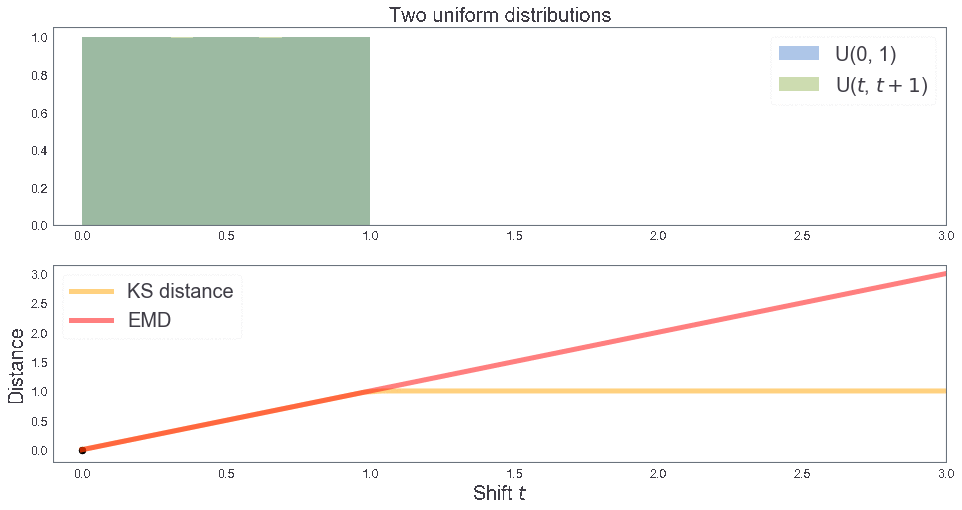
B = [1, 1, 2] # Sample B
T = [1, 1, 2, 3, 3, 3] # Sample T
print("EMD between B and T:", stats.wasserstein_distance(B,T))
v1, w1 = [1, 2], [2, 1] # Sample B
v2, w2 = [1, 2, 3], [2, 1, 3] # Sample T
print("EMD between B and T:", stats.wasserstein_distance(v1, v2, w1, w2))
EMD between B and T: 0.8333333333333333 EMD between B and T: 0.8333333333333333
부산지역 582,184 세대별 도시가스 사용량¶

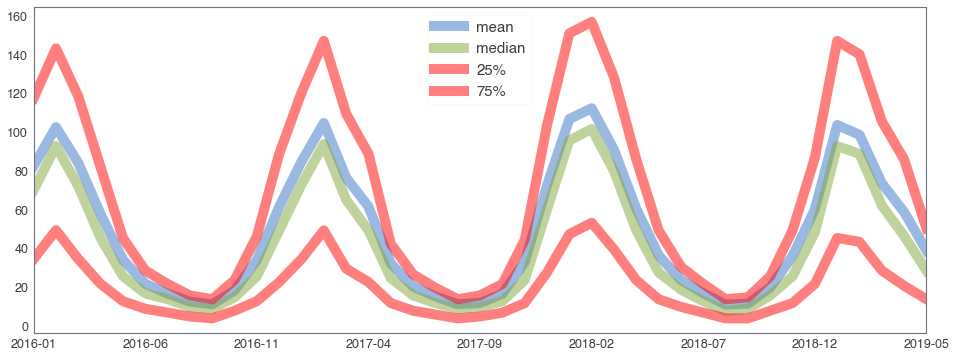
582,184 세대 평균과 유사한 패턴을 띄는 세대 top 50¶
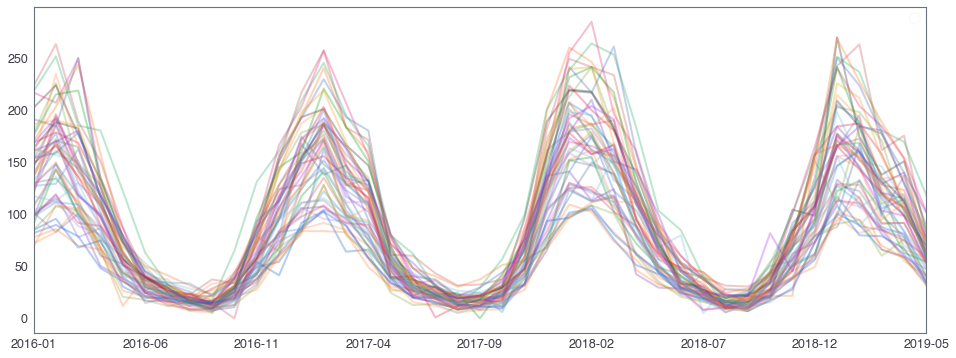
582,184 세대 평균과 다른 패턴을 띄는 세대 top 2000¶
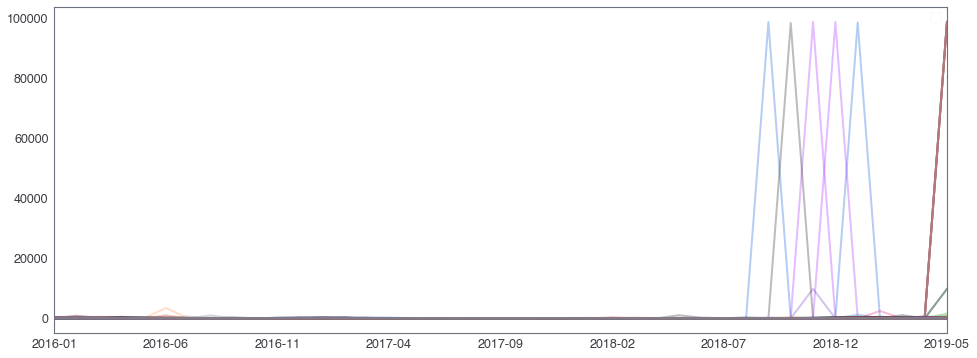
58,2184 세대 평균과 다른 패턴을 띄는 세대¶
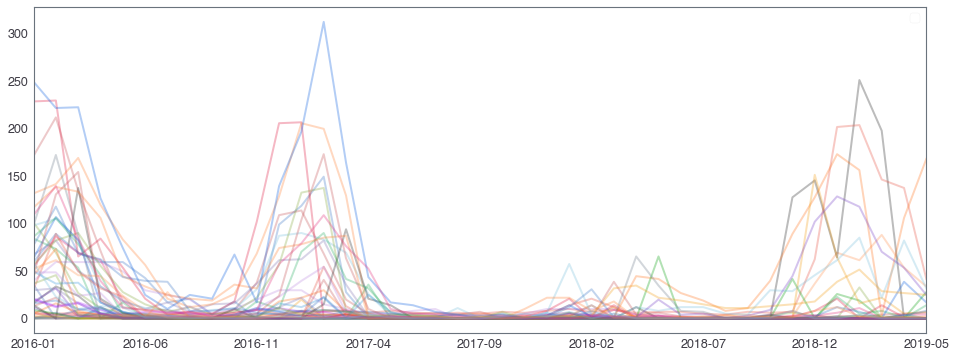
Earth mover's distance with Linear programming¶
Treat each sample set $B$ corresponding to a “point” as a discrete probability distribution, so that each sample $x \in B$ has probability mass $p_x = 1 / |B|$. The distance between $B$ and $T$ is the optional solution to the following linear program.
Each $x \in B$ corresponds to a pile of dirt of height $p_x$, and each $y \in T$ corresponds to a hole of depth $p_y$. The cost of moving a unit of dirt from $x$ to $y$ is the Euclidean distance $d(x, y)$ between the points (or whatever hipster metric you want to use).
Let $\gamma(x, y)$ be a real variable corresponding to an amount of dirt to move from $x \in B$ to $y \in T$, with cost $d(x, y)$. Then the constraints are:
- Each $\gamma(x, y) \geq 0$, so dirt only moves from $x$ to $y$.
- Every pile $x \in B$ must vanish, i.e. for each fixed $x \in B$, $\sum_{y \in T} \gamma(x, y) = p_x$.
- Likewise, every hole $y \in T$ must be completely filled, i.e. $\sum_{x \in B} \gamma(x, y) = p_y$.
The objective is to minimize the cost of doing this: $\sum_{x, y \in B \times T} d(x, y) \gamma(x, y)$.
import math
import numpy as np
from collections import Counter
from collections import defaultdict
from ortools.linear_solver import pywraplp
def euclidean_distance_2(x, y):
return math.sqrt(sum((a - b) ** 2 for (a, b) in zip(x, y)))
def euclidean_distance_1(x, y):
return math.sqrt((x - y) ** 2 )
def earthmover_distance(p1, p2):
if np.array(p1).shape[-1] == 2:
euclidean_distance = euclidean_distance_2
else:
euclidean_distance = euclidean_distance_1
'''
Output the Earthmover distance between the two given points.
'''
dist1 = {x: count / len(p1) for (x, count) in Counter(p1).items()}
dist2 = {x: count / len(p2) for (x, count) in Counter(p2).items()}
if len(set(p2).difference(p1)) >0:
for x in set(p2).difference(p1):
dist1[x] = 0.
if len(set(p1).difference(p2)) >0:
for x in set(p1).difference(p2):
dist2[x] = 0.
solver = pywraplp.Solver("earthmover_distance",
pywraplp.Solver.GLOP_LINEAR_PROGRAMMING)
variables = dict()
dirt_leaving_constraints = defaultdict(lambda: 0)
dirt_filling_constraints = defaultdict(lambda: 0)
# the objective
objective = solver.Objective()
objective.SetMinimization()
for (x, dirt_at_x) in dist1.items():
for (y, capacity_of_y) in dist2.items():
amount_to_move_x_y = solver.NumVar(0,
solver.infinity(), "z_{%s, %s}" % (x, y))
variables[(x, y)] = amount_to_move_x_y
dirt_leaving_constraints[x] += amount_to_move_x_y
dirt_filling_constraints[y] += amount_to_move_x_y
objective.SetCoefficient(amount_to_move_x_y,
euclidean_distance(x, y))
for x, linear_combination in dirt_leaving_constraints.items():
solver.Add(linear_combination == dist1[x])
for y, linear_combination in dirt_filling_constraints.items():
solver.Add(linear_combination == dist2[y])
status = solver.Solve()
if status not in [solver.OPTIMAL, solver.FEASIBLE]:
raise Exception("Unable to find feasible solution")
for ((x, y), variable) in variables.items():
if variable.solution_value() != 0:
cost = euclidean_distance(x, y) * variable.solution_value()
return objective.Value()
v1 = [1, 1, 2]
v2 = [1, 1, 2, 3, 3, 3]
print(earthmover_distance(v1, v2))
print(stats.wasserstein_distance(v1, v2))
0.8333333333333334 0.8333333333333333
print(earthmover_distance(rvs3[: : 3], rvs4[: : 3]))
# >>> 29 s ± 139 ms per loop (mean ± std. dev. of 7 runs, 1 loop each)
print(stats.wasserstein_distance(rvs3[: : 3], rvs4[: : 3]))
# >>> 424 µs ± 2.81 µs per loop (mean ± std. dev. of 7 runs, 1000 loops each)
Why Wasserstein distance is weak.¶
The learning a probability distribution of a data is very important for machine learning¶
- $\mathbf P_r$: target prob. measure(distribution)
- $\mathbf P_\theta$: prob. measure parametrized by $\theta$
Maximum Likelihood method¶
$$ \max \color{red}{\text{Likelihood}} \iff \min \color{red}{KL(\mathbf P_r | \mathbf P_\theta)} \iff \min\color{red}{\text{cross-entropy}} $$However, $KL$-divergence sometimes overshoot!
Relation between distances¶
Statistical distances¶
- total variation distance, $\delta(\mathbf P, \mathbf P_n)$
- KL-divergence, $KL(\mathbf P | \mathbf P_n)$
- Wasserstein distance, $W(\mathbf P, \mathbf P_n)$
Relation¶
- $\mathbf P$: fixed prob. measure on $(K, \mathcal F)$
- $(\mathbf P_n)_n$: seq. of prob. distributions on $(K, \mathcal F)$
Let $n\to \infty$, then $$ \delta(\mathbf P, \mathbf P_n) \to 0 \iff KL(\mathbf P | \mathbf P_n) \to 0 \iff KL(\mathbf P_n | \mathbf P) \to 0. \qquad (*) $$
Furthermore, $(*)$ with $n\to \infty$ implies
$$ W(\mathbf P, \mathbf P_n) \to 0. $$Finite signed measure space¶
Let $K\subset \mathbf R^d$ be a compact and $\mathcal F:= \mathcal B(K)$. Let $\mu$ be a finite signed measure on $(K, \mathcal F)$ (by Hahn decomposition, uniquely devided by finite measures $\mu_+, \mu_-$) and total variation norm
$$\begin{align*} \| \mu \|_{TV}:&= \sup_{A\in \mathcal F} |\mu(A)| + |\mu(A^c)|\\ &= \mu_+(K) + \mu_-(K) \end{align*}$$Let $$ \mathcal M := \left \{ \mu :\text{finite signed measure on }(K, \mathcal F) \right \}. $$
Then $\mathcal M$ is a Banach space w.r.t. $\| \mu \|_{TV}$.¶
$$ Prob(K):=\text{ all prob. measures on }(K, \mathcal F). $$Then $Prob(K)$ is a closed subspace of $\mathcal M$, complete itself.
For $\mu, \nu \in Prob(K)$, total variation distance defined by
$$ \delta(\mu, \nu):= \| \mu - \nu \|_{TV}= \sup_{A\in \mathcal F} |\mu(A) - \nu(A)| + |\mu(A^c)-\nu(A^c)| $$is a distance in $Prob(K)$.
Continuous function space on a compact set $K$ and its dual¶
Consider
$$ C(K):= \{ f: K \to \mathbf R, \text{ continuous} \} $$with norm $\| f\|_\infty := \max_{x\in K} |f(x)|$. Then $(C(K), \| \cdot \|_\infty)$ is a normed space. Define its dual
$$ C(K)^*:= \{ \phi: C(K) \to \mathbf R, \text{ linear and continuous} \} $$with dual norm $\| \phi \| := \sup_{f\in C(K), \, \|f \|_\infty\leq 1} |\phi(f)|$.
$\Rightarrow$ $(C(K)^*, \|\cdot \|)$ is another normed space.¶
Isometric immersion¶
$$ \Phi: (Prob(K), \delta) \longrightarrow (C(K)^* , \| \cdot \|) $$$$ \Phi(\mu)(f) = \int_K f d\mu, \quad\text{ for }\, f \in C(K), \, \mu\in Prob(K) $$Then $\Phi$ is an isometric immersion.
It means that $(Prob(K), \delta)$ can be as a subset of $(C(K)^*, \|\cdot \|)$ or total variation distance $\delta$ over $Prob(K)$ is exactly the norm distance over $C(K)^*$.¶
Dual space $C(K)^*$ has a weak$^*$ topology which is weaker than the strong topology induced by $\| \cdot \|$.
In the case of $Prob(K) (\subset C(K)^*)$, the strong topology is given by the total variation, but weak$^*$ topology is given by the Wasserstein distance.¶
Consider two probability measure $\mathbf P, \mathbf Q$ on $(K, \mathcal F)$.
1. Total variation distance¶
$$ \delta(\mathbf P, \mathbf Q):= \| \mathbf P - \mathbf Q \|_{TV} = \sup_{A\in \mathcal F} | \mathbf P(A) - \mathbf Q(A)| + |\mathbf P(A^c)-\mathbf Q(A^c)| $$2. $KL$-divergence(Kull back-Leibler)¶
$$ KL(\mathbf P | \mathbf Q) := \int_K \log \left (\frac{p(x)}{q(x)} \right) p(x) \mu (dx) $$where $\mathbf P$ and $\mathbf Q$ are absolutely continuous w.r.t. $\mu$ on $K$ $(A\in \mathcal F$ if $\mu(A) = 0 $, then $\mathbf P(A) = \mathbf Q(A) = 0)$.
3. Jensen-Shannon(JS) divergence¶
$$ JS(\mathbf P, \mathbf Q):= KL(\mathbf P | \mathbf M) + KL(\mathbf Q | \mathbf M) $$where $\mathbf M:= (\mathbf P + \mathbf Q)/2$.
4. EM distance, 1$^{st}$ Wasserstein distance¶
$$ \inf_{\gamma \in \Gamma(\mathbf P, \mathbf Q)} E_{(x,y)\sim \gamma} [|x-y|] $$Let $\mathbf P$ be a prob. measure on $K$ and $(\mathbf P_n)_n$ be a seq. of prob. measures on $K$.¶
1. The following statements are equivalent.¶
$$\begin{align*} & \delta(\mathbf P_n , \mathbf P) \to 0 \text{ as }n \to \infty.\\ & \qquad \qquad \qquad\qquad\qquad\qquad (*)\\ & JS(\mathbf P_n , \mathbf P) \to 0 \text{ as } n \to \infty. \end{align*}$$2. The following statements are equivalent.¶
$$\begin{align*} & W(\mathbf P_n , \mathbf P) \to 0 \text{ as }n \to \infty.\\ & \\ & \mathbf P_n \to \mathbf P\text{ converges in distribution for r.v. as }n \to \infty \end{align*}$$3. $KL(\mathbf P_n | \mathbf P) \to 0$ or $KL(\mathbf P | \mathbf P_n) \to 0$ as $n\to \infty$ implies $(*)$¶
4. 1. implies 2.¶
Reference¶
- On Wasserstein Two-Sample Testing and Related Families of Nonparametric Tests
- Concrete representation of abstract (m)-spaces (a characterization of the space of continuous functions)
- Optimal Transport
- Wasserstein GAN
- Earthmover Distance: https://jeremykun.com/tag/wasserstein-metric/





